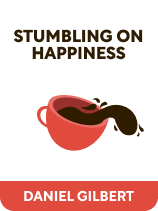

This article is an excerpt from the Shortform book guide to "Stumbling on Happiness" by Daniel Gilbert. Shortform has the world's best summaries and analyses of books you should be reading.
Like this article? Sign up for a free trial here .
Are you considering reading Stumbling on Happiness by Daniel Gilbert? How was the book received by the public and critics?
If you’re looking for a how-to guide on happiness, look elsewhere. In Stumbling on Happiness, Harvard psychology professor Daniel Gilbert shows how, despite our best efforts, we often fail to make choices that maximize our future happiness. It seems that we more often stumble on happiness than successfully create it.
Here’s our Stumbling on Happiness review.
Book Overview
In Stumbling on Happiness, Harvard professor Daniel Gilbert presents a fundamental problem with humans’ quest for happiness: In the present, you make choices and take actions to bring about future events that you believe will make you happy. However, those choices and actions don’t always make you happy and often make you actively unhappy.
Gilbert’s explanation for this is that your imagination (which you use to envision the future and what will bring you the most joy), your memory, and your perception of the present are largely inaccurate. When you use these inaccurate and poorly-informed visions of the future, present, and past to make choices about what to do in the future, your choices are often poor and hinder future happiness. This means that frequently, the best way to find happiness is not to deliberately plan for it but to simply stumble upon it by accident.
About the Author
Daniel Gilbert is an award-winning writer, teacher, and researcher in social psychology. His interests include decision-making, humans’ relationship to the future, and social inference—how humans attempt to understand each other. He’s currently the Edgar Pierce Professor of Psychology at Harvard University.
Gilbert has published prolifically and has featured in The New York Times, Forbes, Scientific American, The New Yorker, Science, O: The Oprah Magazine, and Psychology Today. In 2014, Science wrote that Gilbert was one of the 50 most popular scientists on Twitter.
Gilbert has also appeared on-screen: He co-wrote and hosted a NOVA series called This Emotional Life in which he explored human emotional well-being. Gilbert’s 2004 TED Talk, The Surprising Science of Happiness, based on his research for Stumbling on Happiness, has over 19 million views. He’s even appeared on The Late Show with Stephen Colbert to discuss how people can take small steps to increase their happiness, as well as in Prudential commercials.
Connect With Daniel Gilbert:
The Book’s Publication
Publisher: Penguin Random House
Stumbling on Happiness was published in 2006 and won the Royal Society Prize for Science Books the following year. It was on the New York Times best-seller list for six months and sold over a million copies across the world.
Intellectual Context
Just before turning his attention to happiness, Gilbert primarily studied the fundamental attribution error: the human conviction that others’ actions are the result of their personality while our actions are the result of external circumstances. It was only when he went through a prolonged period of personal difficulty that he began wondering why we so often mispredict how we’ll feel in the future and what will make us happy. This led Gilbert to conduct experiments on humans’ ability to predict their future emotional states. His findings from this research formed the foundation for Stumbling on Happiness.
Stumbling on Happiness is part of an ever-growing body of work on positive psychology: the study of human happiness. However, the book occupies a unique space in this field because it doesn’t offer actionable advice on how to be happy, instead focusing on why we’re wired to sabotage our future happiness. Other positive psychology works that offer a more action-oriented approach to achieving happiness include:
- Dan Harris’s 10% Happier—Retired journalist Dan Harris outlines his journey to greater happiness through meditation and mindfulness and shows how you can do the same.
- Russ Harris’s The Happiness Trap—Harris proposes you escape the happiness trap—the constant and anxiety-provoking pursuit of happiness—by accepting suffering in your life.
- Jay Shetty’s Think Like a Monk—Shetty argues that you can achieve lasting peace and happiness by adopting the mental habits of monks.
The Book’s Impact
Stumbling on Happiness is widely acknowledged as an important and valuable contribution to the field of positive psychology and popular science literature, as evidenced by its receipt of the Royal Society Prize for Science Books—an award for popular science books previously given to Stephen Hawking and Bill Bryson. The book has also turned Gilbert into a sought-after expert for educational TV shows, documentaries, and talks.
Critical Reception
Stumbling on Happiness reviews are mostly positive. Reviewers found Gilbert’s arguments clear, his evidence strong, and his writing style humorous and engaging. They also appreciated Gilbert’s comprehensiveness. He includes more than just enough information to support his thesis: Instead, he explores in detail how our minds work (and often fail to work as expected). Finally, satisfied readers argue that anyone with an interest in human cognition, not just in human happiness, will find something interesting and useful here.
Readers who didn’t enjoy the book felt that its title was misleading—they expected to learn how to stumble on happiness. Others felt that Gilbert’s explanations were too long and that the book was padded with unnecessary background and tangential information. A final complaint was that Gilbert’s writing style was too slick and that he wrote flippantly about serious subjects, like death and suffering.
Commentary on the Book’s Approach
As discussed above, Stumbling on Happiness is not a self-help book about how to find happiness: It’s a book about decision-making and imagination and how these faculties fail to produce the happiness we think they should. Gilbert offers no advice on how to counteract our tendencies to make predictions and choices that limit our happiness, focusing only on how and why we do so.
Much of the book is an explanation of how our minds work, backed up by scientific evidence. The main idea—that our imaginings of the future, memories of the past, and perception of the present are fabricated and thus form the foundation for poor choices that don’t make us happy in the future—takes up relatively little page space. This is, in large part, a necessity, as some of Gilbert’s principles are complex and require significant background information to grasp. For instance, he must explain first how selective and subjective memory is before he can describe how a selective and subjective memory forms the basis for poor decisions about the future.
However, at times, Gilbert arguably gets lost in the finer points of his research and doesn’t spend enough time explaining his thesis. For instance, he dedicates a lot of page space to describing how our personal definitions of happiness differ, a point that’s not central to the book’s main idea.
Commentary on the Book’s Organization
Gilbert breaks his book into six parts. In the first part, “Prospection,” he describes why humans think about the future in the first place. In the second part, “Subjectivity,” Gilbert explains why it’s difficult to discuss happiness objectively and presents ways for us to overcome the obstacles to doing so.
The next three parts—the bulk of the book—describe the three major flaws of the human imagination that cause you to make poor choices about your future. Gilbert labels these parts “Realism” (your failure to imagine the future accurately), “Presentism” (your tendency to imagine the future based on events and experiences in the present), and “Rationalization” (your tendency to rationalize even initially terrible decisions as positive). In each part, he dives deeply into the cognitive processes underlying each individual flaw, as well as the problems that each flaw causes.
Gilbert then concludes with a part called “Corrigibility,” in which he explains why we can never correct these three flaws of our imaginations.
Gilbert’s structural choice of attributing a detailed part to each flaw of the imagination means the reader develops a firm understanding of each individual flaw and how it occurs. However, this siloed structure, with very little information connecting the flaws to each other and to the rest of the book, can make it easy to lose track of the book’s overarching thesis: that, because you fabricate a large part of your perception of reality, you use incorrect information when making decisions about the future and consequently become unhappy. In particular, since Gilbert explains the neurological origin of each flaw in great detail, it’s easy to become bogged down in explanations of human cognition and fail to connect these explanations to the thesis.

———End of Preview———
Like what you just read? Read the rest of the world's best book summary and analysis of Daniel Gilbert's "Stumbling on Happiness" at Shortform .
Here's what you'll find in our full Stumbling on Happiness summary :
- A look at how your brain fabricates your reality leading you to make bad decisions
- The six specific types of bad choices people make
- How to improve your decision-making in the future






